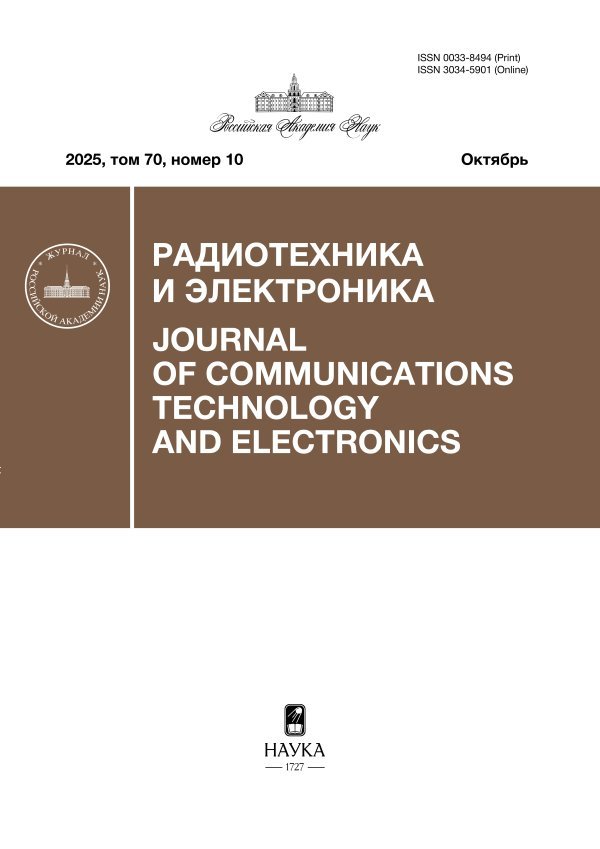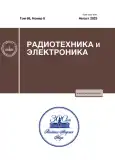Algorithmic Solutions in the Problem of Evaluating the Quality of Communication with an Unmanned Aerial Vehicle
- Authors: Polyanskii I.S.1, Shapovalov Y.D.1
-
Affiliations:
- Academy of the Federal Security Service of the Russian Federation
- Issue: Vol 68, No 8 (2023)
- Pages: 763-771
- Section: К 100-ЛЕТИЮ Б.В. СЕСТРОРЕЦКОГО
- URL: https://rjsvd.com/0033-8494/article/view/650485
- DOI: https://doi.org/10.31857/S0033849423080090
- EDN: https://elibrary.ru/UVNRVK
- ID: 650485
Cite item
Abstract
Algorithmic solutions have been developed to assess the quality of communication with an unmanned aerial vehicle. The quality of communication is determined by the probability of a symbol error at the input of an error-correcting encoder, the a priori calculation of which is performed in the approximation of Rice’s communication channel model. The main attention in the solution is given to the determination of attenuation due to the combined influence of the terrain and tropospheric refraction on the energy parameters of the line ground communication point–unmanned aerial vehicle. The attenuation was calculated by jointly solving a pair of parabolic equations formed from the two-dimensional Helmholtz equation in narrow- and wide-angle approximations by the pseudospectral method of separating the steps of a pair of parabolic equations. In the features of the main stages of the algorithmic implementation of the developed solution are highlighted, and its performance is tested on specific test examples.
About the authors
I. S. Polyanskii
Academy of the Federal Security Service of the Russian Federation
Email: van341@mail.ru
Oryol, 302015 Russia
Ya. D. Shapovalov
Academy of the Federal Security Service of the Russian Federation
Author for correspondence.
Email: van341@mail.ru
Oryol, 302015 Russia
References
- Концепция интеграции беспилотных воздушных судов в единое воздушное пространство Российской Федерации: распоряжение Правительства Российской Федерации от 5 октября 2021 г. № 2806-р.
- Гетьман М.А., Аралбаев Т.З. // Вестн. Уфим. гос. авиацион. технич. ун-та. 2020. Т. 24. № 4. С. 94.
- Васильченко А.С., Иванов М.С., Колмыков Г.Н. // Системы управления, связи и безопасности. 2019. № 4. С. 403.
- Bepбa B.C. // PЭ. 2022. T. 67. № 1. C. 68.
- Куликов Г.В., Тамбовский С.С. // Вестн. МГТУ МИРЭА. 2015. № 1. С. 205.
- Фокин Г.А. // Труды учеб. заведений связи. 2018. Т. 4. № 4. С. 85.
- Bing L. // Procedia Computer Sci. 2017. V. 107. P. 550.
- Khuwaja A.A., Chen Y., Zhao N. et al. // IEEE Commun. Surveys & Tutorials. 2018. V. 20, № 4. P. 2804.
- Архипов Н.С., Полянский И.С., Яковлев Ю.Н. и др. // Физика волновых процессов и радиотехнические системы. 2021. Т. 24. № 3. С. 70.
- Прокис Дж. Цифровая связь. М.: Радио и связь, 2000.
- Полянский И.С., Сомов А.М., Клюев Д.С. и др. Теория электромагнитного поля и распространение радиоволн. М.: Горячая линия-Телеком, 2023.
- Попов В.И. // Евразийский союз ученых. 2015. № 11-3(20). С. 107.
- Тихомиров А.В., Омельянчук Е.В., Семенова А.Ю. и др. // Инженерный вестн. Дона. 2018. № 4. С. 53.
- Архипов Н.С., Архипов С.Н., Полянский И.С. и др. Методы анализа волноводных линий передачи. М.: Горячая линия-Телеком, 2017.
- Russer P., Balanis C.F. Electromagnetics, Microwave Circuit and Antenna Design for Communications Engineering. N.Y.: Morgan and Claypool, 2006.
- Сестрорецкий Б.В. // Вопр. радиоэлектроники. Сер. Общетехническая. 1976. № 2. С. 113.
- Иванов С.А., Сестрорецкий Б.В., Боголюбов А.Н. // Вычислительные методы и программирование. 2008. Т. 9. № 3. С. 274.
- Gaul L., Kogl M., Wagner M. Boundary Element Methods for Engineers and Scientists. Berlin: Springer, 2012.
- Ильинский А.С., Полянский И.С., Степанов Д.Е. // Вест. Удмурт. ун-та. Математика. Механика. Компьютерные науки. 2021. Т. 31. № 1. С. 3.
- Полянский И.С. // Физика волновых процессов и радиотехнические системы. 2018. Т. 21. № 3. С. 36.
- Десятченко Д.В., Коцулевский С.В., Сотников В.О. и др. // Радиотехника. 2020. Т. 84. № 8(15). С. 37.
- Кирпичникова Н.Я., Попов М.М. // Зап. науч. семинара ПОМИ. 2012. Т. 409. С. 55.
- Apaydin G., Sevgi L. Radio Wave Propagation and Parabolic Equation Modeling. N.Y.: Wiley-IEEE Press, 2018.
- Xiao-Wei G., Li-Xin G., Ya-Jiao W. et al. // Intern. J. Antennas and Propagation, 2018.
- Donohue D.J., Kuttler J.R. // IEEE Trans. 2000. V. AP-48. № 2. P. 260.
- Ахияров В.В. // Радиотехника. 2020. № 5. С. 47.
- Emerging Problems in the Homogenization of Partial Differential Equations / Eds. by P. Donato, M. Luna-Laynez. Berlin: Springer, 2021.
- Ахияров В.В. // Журн. радиоэлектроники. 2012. № 1. jre.cplire.ru/jre/jan12/16/text.pdf.
- Barrios A.E. // IEEE Trans. 1994. V. AP-42. № 1. P. 90.
- Pitolli F., Sorgentone C., Pellegrino E. // Algorithms. 2022. V. 15. № 2. P. 69.
- Apaydin G., Ozgun O., Kuzuoglu M. et al. // IEEE Trans. 2011. V. GRS-49. № 8. P. 2887.
Supplementary files
















